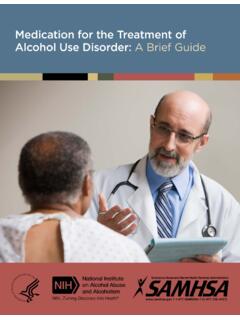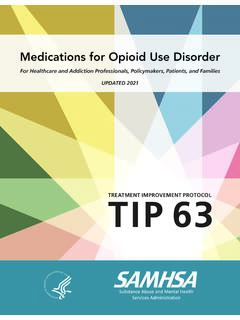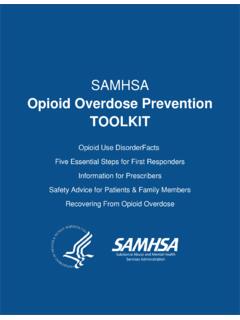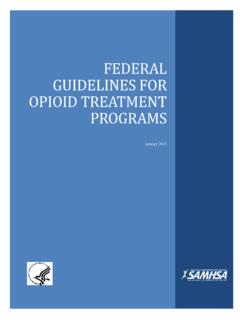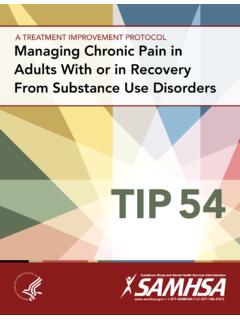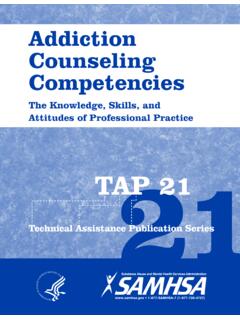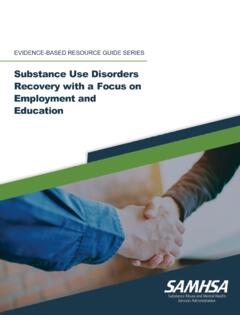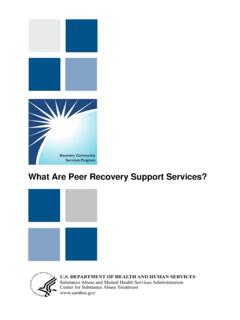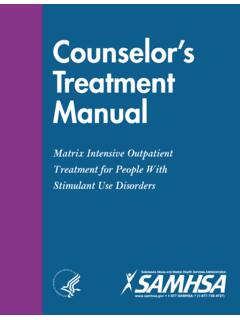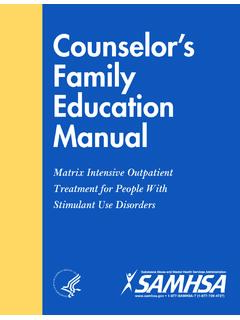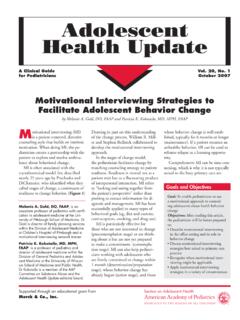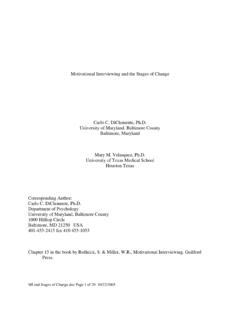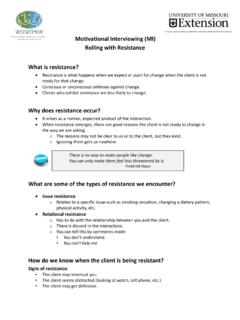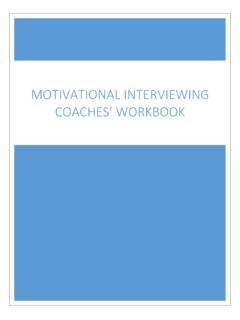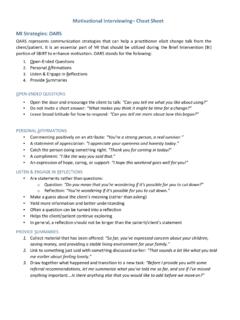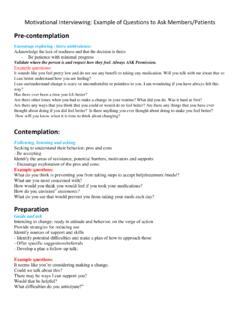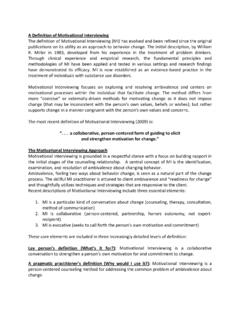Transcription of SAMHSA TIP 35 Enhancing Motivation for Change in …
1 Enhancing Motivation for Change in substance Use Disorder Treatment TITREATMENT IPMPROVEMENT 35 PROTOCOL UPDATED 2019 This page intentionally left blankTIP 35 Please share your thoughts about this publication by completing a brief online survey at: The survey takes about 7 minutes to complete and is anonymous. Your feedback will help SAMHSA develop future products. iii This page intentionally left blankTIP 35 Contents Foreword viii Executive Summary ix TIP Development Participants xv Publication Information xxi Chapter 1 A New Look at Motivation 1 Motivation and Behavior Change 4
2 Changing Perspectives on Addiction and Treatment 6 TTM of the SOC 13 Conclusion 16 Chapter 2 motivational Counseling and Brief Intervention 17 Elements of Efective motivational Counseling Approaches 17 motivational Counseling and the SOC 23 Special Applications of motivational Interventions 26 Brief motivational Interventions 30 Screening, Brief Intervention.
3 And Referral to Treatment 32 Conclusion 33 Chapter 3 motivational interviewing as a Counseling Style 35 Introduction to MI 35 What Is New in MI 37 Ambivalence 38 Core Skills of MI: OARS 41 Four Processes of MI 48 Benefts of MI in Treating SUDs 63 Conclusion 64 Chapter 4 From Precontemplation to Contemplation.
4 Building Readiness 65 Develop Rapport and Build Trust 66 Raise Doubts and Concerns About the Client s substance Use 71 Treatment 77 Conclusion 81 Understand Special motivational Counseling Considerations for Clients Mandated to Chapter 5 From Contemplation to Preparation: Increasing Commitment 83 Normalize and Resolve Ambivalence 84 Help Tip the Decisional Balance Toward Change 87 Conclusion 93 v TIP 35 Enhancing Motivation for Change in substance Use Disorder Treatment Chapter 6 From Preparation to Action.
5 Initiating Change 95 Explore Client Change Goals 96 Develop a Change Plan 99 Support the Client s Action Steps 107 Evaluate the Change Plan 108 Conclusion 108 Chapter 7 From Action to Maintenance: Stabilizing Change 109 Stabilize Client Change 110 Support the Client s Lifestyle Changes 117 Help the Client Reenter the Change Cycle 120 Conclusion 124 Chapter 8 Integrating motivational Approaches in SUD Treatment Settings 125 Adaptations of motivational Counseling Approaches 126 Workforce Development
6 131 Conclusion 135 Appendix A Bibliography 137 Appendix B Screening and Assessment Instruments 149 1 U S Alcohol Use Disorders Identifcation Test (AUDIT) 150 2 Drug Abuse Screening Test (DAST-10) 152 3 Drinker Inventory of Consequences (DrInC) (Lifetime) 154 4 What I Want From Treatment (2 0) 157 5 Readiness to Change Questionnaire (Treatment Version) (RCQ-TV) (Revised) 160 6 Stages of Change Readiness and Treatment Eagerness Scale Alcohol (SOCRATES 8A) 162 7 Stages of Change Readiness and Treatment Eagerness Scale Drug (SOCRATES 8D) 164 8 University of Rhode Island Change Assessment (URICA) Scale 168 9 Alcohol and Drug Consequences Questionnaire (ADCQ)
7 171 10 Alcohol Decisional Balance Scale 173 11 Drug Use Decisional Balance Scale 175 12 Brief Situational Confdence Questionnaire (BSCQ) 177 13 Alcohol Abstinence Self-Efcacy Scale (AASES) 179 14 motivational interviewing Knowledge Test 181 Appendix C Resources 186 motivational interviewing and motivational Enhancement Therapy 186 Stages of Change 186 Training and Supervision 186 substance Abuse and Mental Health Services Administration 187 vi TIP 35
8 Exhibits Exhibit 1 1 Models of Addiction 7 Exhibit 1 2 Examples of Natural Changes 13 Exhibit 1 3 The Five Stages in the SOC in the TTM 14 Exhibit 2 1 The Drinker s Pyramid Feedback 19 Exhibit 2 2 Catalysts for Change 24 Exhibit 2 3 Counselor Focus in the SOC 25 Exhibit 2 4 RESPECT: A Mnemonic for Cultural Responsiveness 27 Exhibit 3 1 A Comparison of Original and Updated Versions of MI 37 Exhibit 3 2 Misconceptions and Clarifcations About MI 38 Exhibit 3 3 Examples of Change Talk and Sustain Talk 40 Exhibit 3 4 Closed and Open Questions 41 Exhibit 3 5 Gordon s 12 Roadblocks to Active Listening 44 Exhibit 3 6 Types of Refective Listening Responses
9 46 Exhibit 3 7 Components in a Sample Agenda Map 51 Exhibit 3 8 Examples of Open Questions to Evoke Change Talk Using DARN 53 Exhibit 3 9 The Importance Ruler 54 Exhibit 3 10 The Confdence Ruler 60 Exhibit 4 1 Counseling strategies for Precontemplation 66 Exhibit 4 2 Styles of Expression in the Precontemplation Stage: The 5 Rs 69 Exhibit 4 3 An Opening Dialog With a Client Who Has Been Mandated to Treatment 79 Exhibit 5 1 Counseling strategies for Contemplation 84 Exhibit 5 2 The motivational interviewing (MI) Hill of Ambivalence 85 Exhibit 5 3 Decisional Balance Sheet for substance Use 88 Exhibit 5 4 Other Issues in Decisional Balance 89 Exhibit 5 5 Recapitulatio
